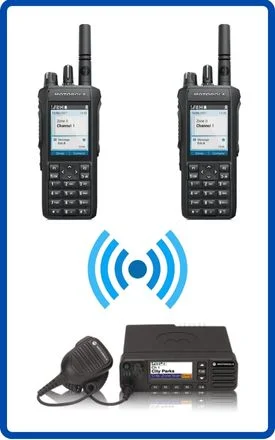
Motorola Radio Systems | Simplex (Radio to Radio) Direct Mode
Direct Communication with Simplex: Streamlined Radio-to-Radio Connectivity
Simplex (Radio to Radio) Direct Mode
Simplex direct mode, often referred to as “radio to radio” or “simplex communication,” is a type of two-way radio operation where two or more radios communicate directly with each other on the same frequency without the use of a repeater or infrastructure.
As an example, a small manufacturing facility may have workers use MOTOTRBO in Direct Mode to coordinate their activities. The loading dock can call the foreman when parts have arrived, and the factory manager can call down to the shop floor to prioritize an urgent order.
All MOTOTRBO radios have the capability to connect directly, radio-to-radio, for basic voice, data, text and applications support. But this approach has limitations. For your workforce to communicate, every radio needs to be in range of every other radio. That’s not easy when one of your workers is in the basement, and another is out serving a customer.
In simplex mode, communication is bidirectional, meaning that each radio can both transmit and receive on the same frequency.
Here's how simplex direct mode works:
Frequency: All radios involved in the communication are tuned to the same radio frequency.
Transmitting and Receiving: When a user wants to transmit a message, they press the push-to-talk (PTT) button on their radio. While they are transmitting, they cannot receive messages from others because the radio is using the same frequency for both transmitting and receiving.
Limitations: Simplex communication has limited range, as the signal strength diminishes with distance. This range can be affected by factors such as terrain, obstacles, and the power output of the radios. In urban environments, buildings and structures may obstruct signals, reducing the effective range even further.
Interference: Since all radios are on the same frequency, there is a potential for interference when multiple users try to transmit simultaneously. This can lead to collisions and garbled transmissions.Use Cases: Simplex communication is commonly used in short-range applications, such as family radios, and some business or industrial settings where users are in close proximity and do not require long-distance communication.
Basic Communications
Single Location / Very Few Users / Close Proximity
- Limited range, basic feature-set
- Good for very small operations
- Radios must always be within range of each other, or someone will miss a call
- Limited application support
It’s important to note that simplex communication may not be suitable for situations that require extended coverage or reliable long-distance communication, as it lacks the benefits of repeaters or infrastructure that can extend the range and reliability of radio communication. In such cases, a repeater system or a more complex radio network may be necessary.






